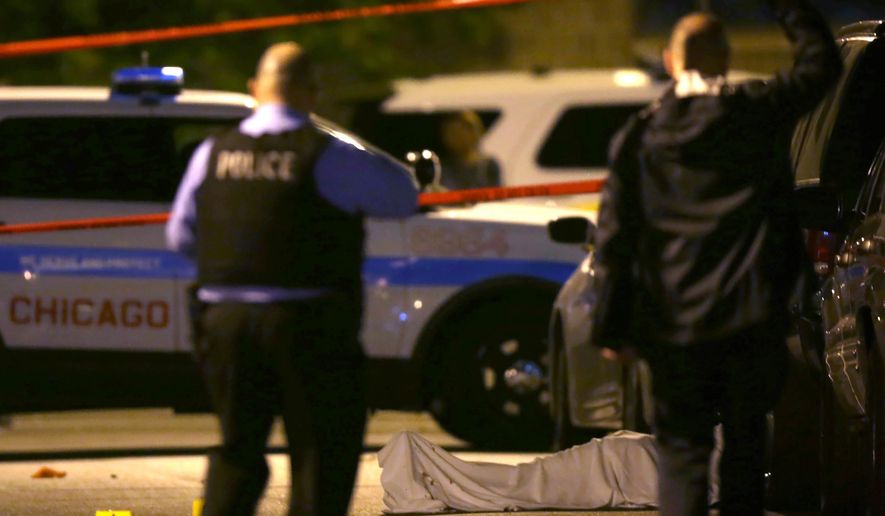Violent crime against Black Americans has dropped 43% over the past 14 years, and they are now less likely to be victims of violent crime than White or Hispanic people, according to data from the Bureau of Justice Statistics.
The surprising study undercuts claims by racial justice activists that there is a war on Black people and the Trump administration’s narrative that violent crime is rising in urban areas.
“If you look at this data, it refutes the idea that crime is out of control in Black communities but also the racial justice narrative that Whites are murdering us,” said Wilfred Reilly, who teaches political science at Kentucky State University and is also a Black man.
The Bureau of Justice Statistics, a branch of the Justice Department, found that violent crime against Black people dropped faster than violent crime against White people (24%) and Hispanic people (18%) from 2005 to 2019.
By 2019, 18.7 Black people per 1,000 were victimized by a violent crime that year, compared with 21 Whites and 21.3 Hispanics per 1,000 people of those ethnicities, respectively.
The data still offers talking points for both the right and the left.
Protests broke out across the country this summer in response to the death of George Floyd and other Black men and women during encounters with police. Black Lives Matter, which was at the forefront of the demonstrations, claimed the police-related killings were part of a war on Black people that also included violence by White civilians and vigilantes.
Although the bureau didn’t study the race of violent crime perpetrators, Mr. Reilly said, the reduction in violent crime counters the activists’ claims.
“You see racial justice advocates say violence against Black people is constant and coming from the White side of the fence,” he said. “But the truth is, there is an extraordinarily small amount of police violence against Black Americans and there is an extraordinarily small amount of White violence against Black people.
“That is all part of the context of declining crime overall,” he said.
In 2018, 16% of White homicide victims were killed by Black perpetrators, while 8% of Black victims were killed by White attackers, according to the most recent FBI statistics.
“We all want to get rid of residual racism, but it is not accurate to say Blacks and Whites are at war in the streets,” Mr. Reilly said. “It tends to be an extrapolation of two or three situations.”
Meanwhile, President Trump has centered his reelection campaign around the message that he will restore law and order to Democrat-run cities that are full of “anarchy and mayhem.”
Although the Bureau of Justice Statistics used 2019 data, plenty of recent reports also refute that claim. A preliminary 2020 crime report that the FBI published last month found that violent crime in large cities dropped by 7.2% through the first six months of the year.
The coronavirus crisis forced people to remain inside, likely depressing the overall crime numbers, but Mr. Reilly said the FBI’s data reflects trends indicating violent crime is on the decline.
“When you see that between 2014 and 2017, we went from 17,300 murders to 14,000 murders, I’m not sure COVID is going to create any historical lows,” he said.
Experts don’t agree exactly on why the numbers are dropping.
William Sabol, a former director of statistics at Bureau of Justice Statistics, said there are several theories why the number of Black people who are victims of violent crime has dropped.
Mr. Sabol said people weren’t out on the streets as much as they were in the past, even before the COVID-19 pandemic.
Drug dealers are becoming increasingly reliant on cash apps to conduct business. A recent survey of millennials found that nearly one-third had used an online cash app to pay for drugs, including marijuana, cocaine and the stimulant Adderall.
“Drug dealers are using cash apps so the folks who would rob them wouldn’t rob them,” Mr. Sabol said.
Another explanation is the economic gains made in the Black community over the past decade. The Black unemployment rate stands at 12%, down from a high of 16.8% in 2010, according to Census Bureau data. Last year, the poverty rate for Blacks fell below 20% for the first time in history, the Census Bureau found.
“The reality is that you would expect crime to decline as Blacks move to affluent suburbs away from ’hood culture,” Mr. Reilly said. “When you see crimes with a Black victim go down, you are seeing the impact of changes in social class. If you are an accountant, you don’t have time to go wilding in the streets.”
While Mr. Sabol called the study’s findings “reputable and reliable,” he questioned whether researchers were able to reach economically disadvantaged urban Blacks and rural Whites. Excluding poor communities from the study could artificially depress the results, he said.
“One of the challenges is covering the entire population,” he said. “Surveys like this tend to perform poorly with the hard-to-reach population, including homeless and those who don’t have stable addresses.”
Another question is whether the data excluded crimes not reported to police. The study didn’t say whether unreported crimes were included in the findings.
Mr. Reilly disagreed that unreported crime was a factor. He said the survey models are designed to account for unreported crimes and people excluded from the study.
“If you see a decline, that is a real decline,” he said.
• Jeff Mordock can be reached at jmordock@washingtontimes.com.




Please read our comment policy before commenting.